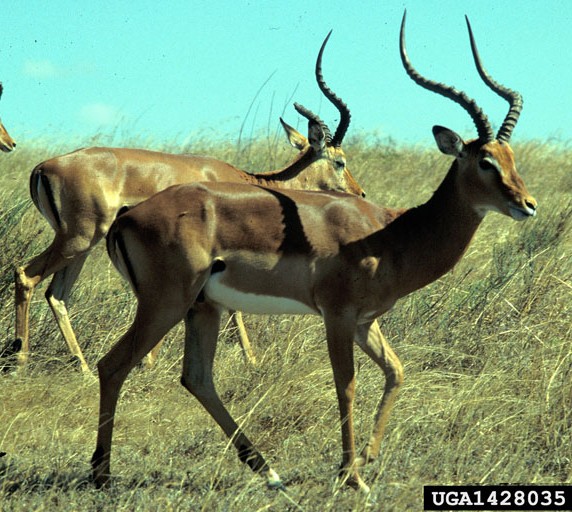|
Our
Beautiful World
|
Impala, Aepyceros melampus

|
|
||||
|
Family Bovidae Subfamily Aepycerotinae Impala, Aepyceros melampus Black-faced impala - Aepyceros melampus petersi Common impala - Aepyceros melampus melampus The impala, Aepyceros melampus, (Greek aipos "high", ceros "horn" + melas "black" pous "foot") is a medium-sized African antelope. The name common name impala comes from the Zulu language meaning "gazelle". They are found in savannas and thick bushveld in Kenya, Tanzania, Swaziland, Mozambique, northern Namibia, Botswana, Zambia, Zimbabwe, southern Angola, northeastern South Africa and Uganda. Impalas can be found in numbers of up to 2 million in Africa.  This antelope specimen has been famous all over the world because of its well proportioned body, its beautiful colors and the impressing horns. The adult impalabull is one of the most beautiful ruminant animals you can meet in Africa. Photographer: William M. Ciesla, http://www.forestryimages.org/ Impala range between 75 and 95 cm tall. Average mass for a male impala is 46 to 76 kg , while females weigh about 35 to 50 kg. They are normally reddish-brown in color (hence the Afrikaans name of "Rooibok"), have lighter flanks and white underbellies with a characteristic "M" marking on the rear. Males, referred to as rams, have lyre-shaped horns, which can reach up to 90 centimeters in length. Females, referred to as ewes, have no horns. The black impala, found in very few places in Africa, is an extremely rare type. A recessive gene causes the black colouration in these animals.  Late in November, right after a fire.. Photographer: Paul Bolstad, http://www.forestryimages.org/ The impala never leave areas with water, and almost never moves into tight woodland or bushes. That is why theyk only get few problems when fire is ravaging violently in an area, like on the picture above.  Male and female. Photographer: Paul Bolstad, http://www.forestryimages.org/ Impalas are an ecotone (a transition area between two biomes but different patches of the landscape, such as forest and grassland), species living in light woodland with little undergrowth and grassland of low to medium height. They have an irregular distribution due to dependence on free water, soils with good drainage with firm footing and moderate or less slope. While they are usually close to water in the dry season, they can go weeks without drinking when they have access to green vegetation. 
Black-faced impala, Aepyceros melampus - overview Granada Wild, c/o ITN Source, London http://www.arkive.org Impalas are adaptable foragers. They usually switch between grazing and browsing depending on the season. During wet seasons when grasses are green and growing they graze. During dry seasons it browses foliage, shoots, forbs and seeds.[4] It can also adapt to different habitats by being a grazer in one habitat a browser in another. Leopards, cheetahs, lions and wild dogs prey on impala.  Photographer: Kenneth M. Gale, http://www.forestryimages.org/ Females and young form herds of up to two hundred individuals. When food is plentiful, adult males will establish territories. Females pass through the territories that have the best food resources.[6] Territorial males round up any female herds that enter their grounds, and will chase away bachelor males that follow  impala-calf © http://www.schmode.net/ (not active as per Sept.2010) The breeding season of impalas, also called rutting, begins toward the end of the wet season in May. The entire affair typically lasts approximately three weeks. While young are usually born after 6–7 months, the mother has the ability to delay giving birth for an additional month if conditions are harsh. When giving birth, a female impala will isolate herself from the herd, despite numerous attempts by the male to keep her in his territory. The impala mother will keep the fawn in an isolated spot for a few days or even leave it lying out in hiding for a few days, weeks, or more before returning to the herd. There, the fawn will join a nursery group and will go to its mother only to nurse and when predators are near. Fawns are suckled for four to six months. Males who mature are forced out of the group and will join bachelor herds.  Oh no, you are not stronger than me! © http://www.schmode.net/ (not active as per Sept.2010) When frightened or startled, the whole herd starts leaping about to confuse their predator. They can jump distances more than 10 meters (33 ft) and 3 meters (9 ft) high. Impalas can reach running speeds of about 80 to 90 km/h (50 to 56 mph),[9][10] to escape their predators. When escaping from predators, they can release a scent from their glands on their heels, which can help them stay together. This is done by performing a high kick of their hind legs.[ |
 ANIMALS over 250 |
 BIRDS over 500 |
 FLOWERS over 225 |





